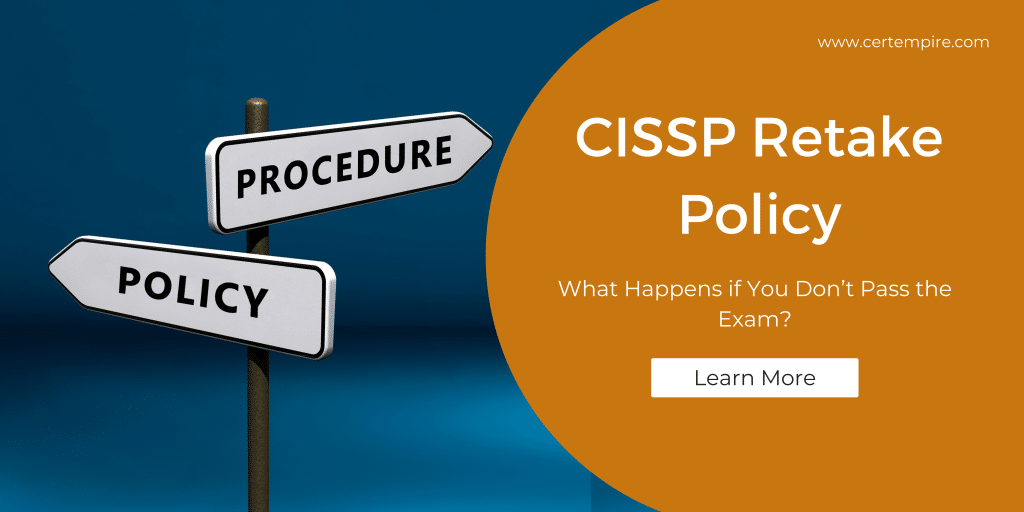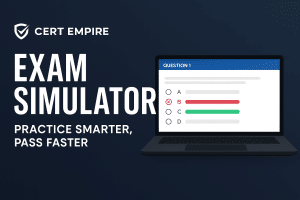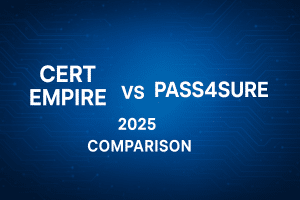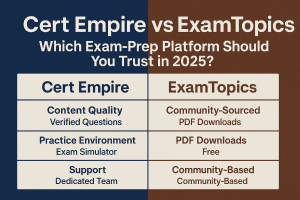The CISSP exam is one of the most prestigious certifications in cybersecurity, and passing it can open doors to numerous career opportunities. However, with its challenging nature, many candidates wonder: What happens if I don’t pass the exam on my first attempt?
Don’t worry—failing the CISSP exam isn’t the end of the road. In fact, ISC2 has a clear retake policy that gives candidates multiple opportunities to try again. In this blog, we’ll break down the CISSP retake policy, including the rules for retaking the exam, waiting periods, and the steps you can take to improve your chances of success the next time around.
TLDR: Too Long; Didn’t Read
If you don’t pass the CISSP exam, you must wait 30 days before retaking it. After multiple attempts, the waiting period increases. You can retake the exam up to four times per year. The CISSP retake policy provides a structured way to keep trying, and with proper preparation, you can successfully pass the exam on the next attempt.
What Is the CISSP Retake Policy?
The CISSP exam is challenging, and many candidates don’t pass on their first attempt. ISC2 provides a retake policy that allows candidates to retake the exam, but there are specific rules that you must follow.
Key Details of the Retake Policy:
- First Attempt: If you fail the exam, you must wait 30 days before you can retake it.
- Second and Third Attempts: If you fail a second or third time, the waiting period increases to 90 days.
- After Multiple Attempts: If you fail the exam four times, ISC2 requires you to wait 1 year before attempting it again.
This policy ensures that candidates have sufficient time to reflect on their mistakes, study the material more thoroughly, and be better prepared for the next attempt.
Why Do You Need to Wait Between Retakes?
The waiting period between attempts is designed to give candidates time to prepare more effectively before retaking the exam. It’s important to remember that the CISSP exam covers a vast range of topics, and retaking it too soon without improving your knowledge could hurt your chances of passing.
The Purpose of the Waiting Period:
- Reflect on Mistakes: Use the waiting period to review your performance, understand where you went wrong, and focus on your weak areas.
- Better Preparation: Waiting gives you more time to thoroughly study the material, utilize new resources, and improve your test-taking strategies.
- Mental Reset: The pressure of a failed attempt can be mentally exhausting. The waiting period allows you to refresh your mind and tackle the exam with a clearer perspective.
CISSP Retake Waiting Periods
| Attempt | Minimum Waiting Period | Notes |
| 1st Failure | 30 days | Earliest you can re-register after your first failed attempt. |
| 2nd Failure | 90 days | Required wait after the second failed attempt. |
| 3rd Failure | 180 days | Third attempt requires a longer gap to allow for more preparation. |
| Annual Limit | 4 attempts | You cannot exceed four attempts in a single 12-month period. |
What Happens After Multiple Failures?
If you fail the CISSP exam four times, ISC2 imposes a one-year waiting period before you can retake the exam again. While this may feel discouraging, it’s important to view it as an opportunity to reassess your approach to studying and improve your preparation strategies.
Steps to Take After Multiple Failures:
- Review Your Mistakes: Carefully go through your exam results to identify the areas where you struggled. Understanding why you failed the exam will guide your study efforts.
- Strengthen Your Weaknesses: Focus on the domains where you struggled the most. Use study materials, practice exams, and forums to strengthen your knowledge in these areas.
- Join Study Groups: Consider joining CISSP study groups or forums (such as Reddit, LinkedIn, or Discord) where you can interact with other candidates and get insights into their strategies.
- Consider Additional Resources: If you’ve been using one study guide or course, it might be time to try something different. Sometimes a new perspective or resource can help clarify tough concepts.
How to Prepare for a Retake
If you fail the CISSP exam and need to retake it, it’s crucial to have a solid preparation strategy in place. Here’s how to get ready for your next attempt:
1. Review the Exam Domains
Take a detailed look at the CISSP domains and understand the weighting of each domain in the exam. Spend extra time on the domains that you found most challenging during your first attempt.
2. Use Practice Exams
Practice exams are essential for helping you get used to the format and timing of the exam. They also help reinforce your knowledge and highlight weak areas.
3. Adjust Your Study Plan
After reviewing your first attempt, adjust your study plan to focus more on areas where you struggled. Use a mix of study materials, including books, videos, online courses, and practice exams.
4. Stay Consistent
It’s essential to stick to a regular study schedule. Consistency is key to reinforcing your understanding of the material and avoiding last-minute cramming.
Recommended Recovery Plan After a Failed Attempt
| Step | Action | Goal |
| 1 | Review exam report to identify weak CISSP domains | Pinpoint where to focus study efforts |
| 2 | Update study plan with more time on low-scoring topics | Strengthen weak areas systematically |
| 3 | Use new practice questions and full-length simulators | Build familiarity with complex scenarios |
| 4 | Join a CISSP study group or coaching session | Gain fresh perspectives and peer insights |
| 5 | Schedule retake strategically (not too soon) | Balance readiness with ISC2 retake window |
Is It Common to Fail the CISSP Exam?
Yes, it’s quite common for candidates to fail the CISSP exam on their first attempt. The exam is designed for experienced professionals, and the content is dense and requires a comprehensive understanding of a wide range of topics.
According to ISC2, about 40-50% of candidates do not pass the CISSP exam on their first try. However, this should not discourage you—many of those who fail the exam the first time go on to pass on their second or third attempt after reevaluating their study approach and improving their preparation.
Quick Summary
If you fail the CISSP exam, you must wait 30 days before retaking it. If you fail more than once, the waiting period increases to 90 days for the second and third attempts. After four failures, you must wait 1 year. Use the waiting periods to reassess your study strategies, strengthen weak areas, and practice with CISSP exam simulators.
Final Thoughts
Failing the CISSP exam can feel discouraging, but it’s not the end of your journey. The CISSP retake policy gives you multiple chances to improve and pass the exam. Use each attempt as a learning opportunity, and with the right preparation and strategy, you’ll eventually succeed. Remember, the CISSP certification is a prestigious credential, and perseverance is key to earning it.
More Resources
For a deeper dive into the CISSP exam, including the full exam breakdown and more tips for preparation, check everything about the CISSP test.
Check out these related blogs for additional help with your CISSP journey:
- Common CISSP Exam Mistakes and How to Avoid Them
- The Best CISSP Practice Questions and Resources for Exam Success
Last Updated on by Team CE



























